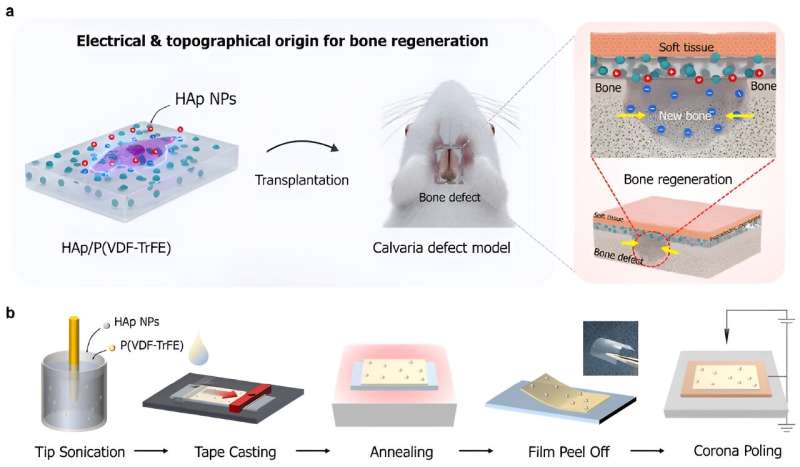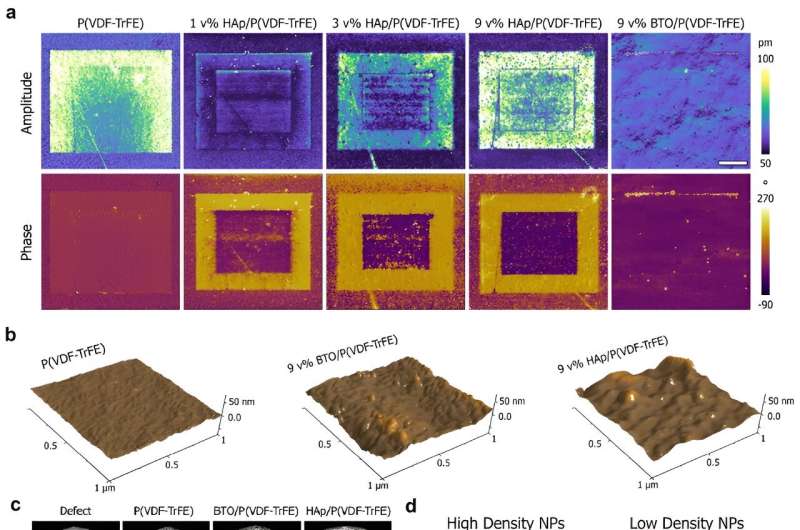

Researchers develop novel 'bone bandage' material for cracked bones
source link: https://phys.org/news/2024-02-bone-bandage-material-bones.html
Go to the source link to view the article. You can view the picture content, updated content and better typesetting reading experience. If the link is broken, please click the button below to view the snapshot at that time.

February 1, 2024
Researchers develop novel 'bone bandage' material for cracked bones
by The Korea Advanced Institute of Science and Technology (KAIST)

Bone regeneration is a complex process, and existing methods to aid regeneration including transplants and growth factor transmissions face limitations such as the high cost. But recently, a piezoelectric material that can promote the growth of bone tissue has been developed.
A KAIST research team led by Professor Seungbum Hong from the Department of Materials Science and Engineering (DMSE) has developed a biomimetic scaffold that generates electrical signals upon the application of pressure by utilizing the unique osteogenic ability of hydroxyapatite (HAp). HAp is a basic calcium phosphate material found in bones and teeth. This biocompatible mineral substance is also known to prevent tooth decay and is often used in toothpaste.
This research was conducted in collaboration with a team led by Professor Jangho Kim from the Department of Convergence Biosystems Engineering at Chonnam National University. The results are published in the journal ACS Applied Materials & Interfaces.
Previous studies on piezoelectric scaffolds confirmed the effects of piezoelectricity on promoting bone regeneration and improving bone fusion in various polymer-based materials, but were limited in simulating the complex cellular environment required for optimal bone tissue regeneration. However, this research suggests a new method for utilizing the unique osteogenic abilities of HAp to develop a material that mimics the environment for bone tissue in a living body.

The research team developed a manufacturing process that fuses HAp with a polymer film. The flexible and free-standing scaffold developed through this process demonstrated its remarkable potential for promoting bone regeneration through in-vitro and in-vivo experiments in rats.
The team also identified the principles of bone regeneration that their scaffold is based on. Using atomic force microscopy (AFM), they analyzed the electrical properties of the scaffold and evaluated the detailed surface properties related to cell shape and cell skeletal protein formation. They also investigated the effects of piezoelectricity and surface properties on the expression of growth factors.
Professor Hong from KAIST's DMSE said, "We have developed a HAp-based piezoelectric composite material that can act like a 'bone bandage' through its ability to accelerate bone regeneration." He added, "This research not only suggests a new direction for designing biomaterials, but is also significant in having explored the effects of piezoelectricity and surface properties on bone regeneration."
More information: Soyun Joo et al, Piezoelectrically and Topographically Engineered Scaffolds for Accelerating Bone Regeneration, ACS Applied Materials & Interfaces (2024). DOI: 10.1021/acsami.3c12575
Recommend
About Joyk
Aggregate valuable and interesting links.
Joyk means Joy of geeK